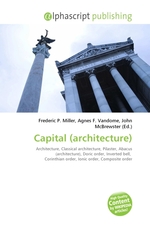High Quality Content by WIKIPEDIA articles! In several traditions of architecture including Classical architecture, the capital (from the Latin caput, 'head') forms the crowning member of a column or a pilaster. The capital projects on each side as it rises, to support the abacus and unite the form of the latter (normally square) with the circular shaft of the column. The bulk of the capital may either be convex, as in the Doric order; concave, as in the inverted bell of the Corinthian order; or scrolling out, as in the Ionic order. These form the three principal types on which all capitals are based. The Composite order (illustration, right) established in the 16th century on a hint from the Arch of Titus, adds Ionic volutes to Corinthian acanthus leaves. From the prominent position it occupies in all monumental buildings, the capital is often selected for ornamentation, and is often the clearest indicator of the architectural order (see Orders of architecture). The treatment of its detail may be an indication of the building's date.
Данное издание не является оригинальным. Книга печатается по технологии принт-он-деманд после получения заказа.


